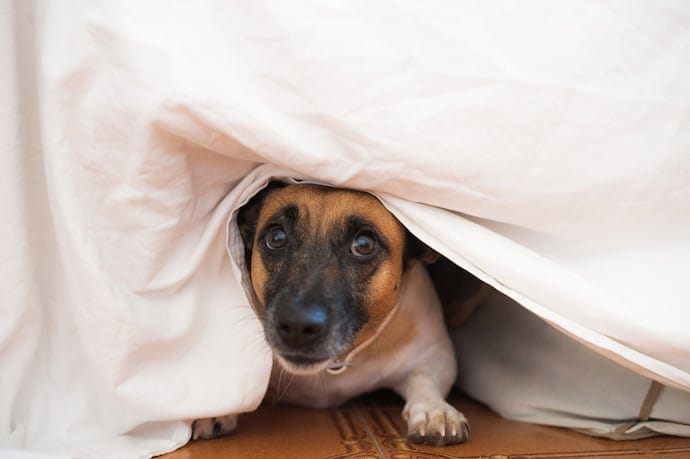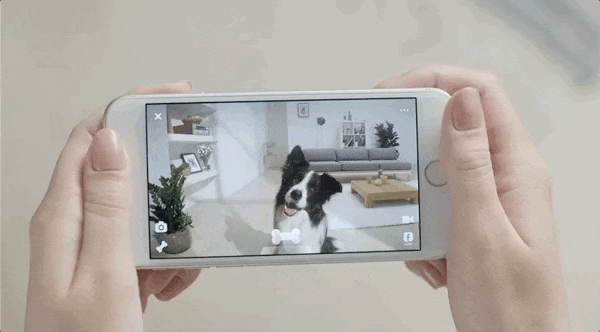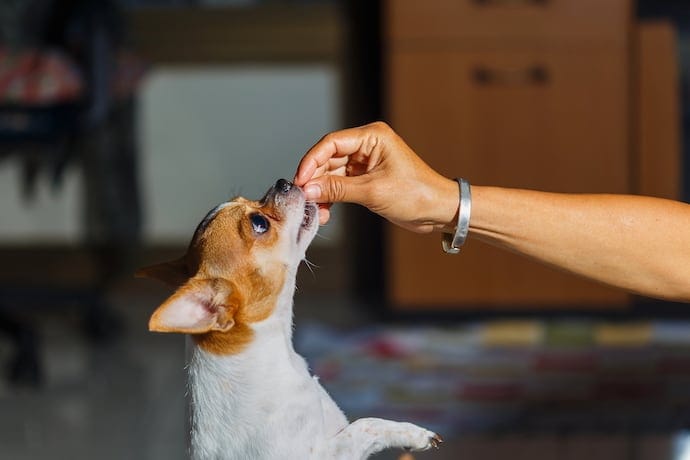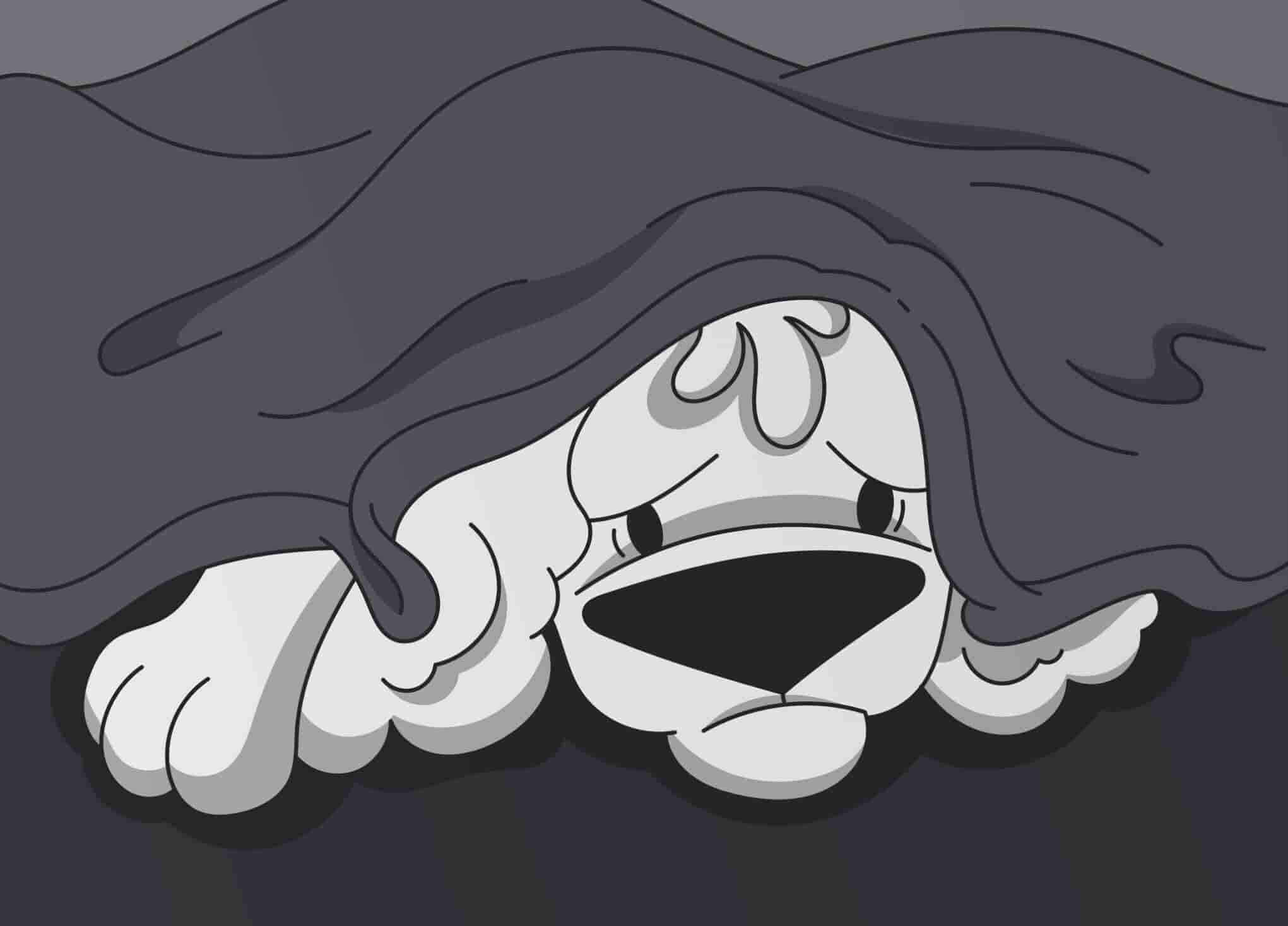When it comes to owners and their emotions, dogs are like mirrors.
What do we mean?
OK. Think of the last time you felt low or even elated. How did your dog react?
The chances are when you felt sad, your dog quietly came over and licked away your tears. And when you were excited, your pup bounced about barking and wagging their tail. Dogs mirror the mood of their owner.

Do Dogs Get Depressed?
So if a dog seems sad, are they depressed or reflecting their pet parent’s mood?
This is a tricky question to answer because dogs can’t talk. However, what we can say is that dogs do show symptoms of what looks like depression.
In this article we review how to ‘read’ your dog’s body language for signs of depression. And know what to do (and what not to do) to put a bounce back in their step.
Can Dogs Get Depressed?
No-one knows for sure if dog depression is a real thing. But it’s a reasonable assumption they suffer from low mood and sadness…or depression by another name.
Even in humans there is no clinical test to diagnose depression. Instead, the condition is diagnosed by talking to the patient about their feelings.
Is My Dog Depressed?
Our dogs give us clues when they feel down through changes in their habits. Signs of depression in dogs include:
- Losing interest in play
- Reduced appetite
- Sleeping all day
- Short temper
- Hiding
- Not getting up to greet you
Especially when these changes coincide with a change in circumstances then this may well be dog depression. But…and it’s a big BUT….is the dog sick rather than depressed?
Depression…Or in Pain?
Take the following example:
Your normally bouncy 10-year-old Labrador refuses to go for walks and instead sleeps all day. What’s going on?
- They are depressed
- They have arthritis
- You can’t tell and should visit the vet
The correct answer is c). Pain will cause a dog to become withdrawn, and the best person to diagnose this is the vet.
Never assume depression without first checking in with a vet. There’s a huge cross over in symptoms between a depressed dog and ill health. Only once the dog receives the all-clear from the vet, is it safe to assume a low mood.
How to Tell if your Dog is Depressed
Dogs can’t tell us they are sad, write soulful poetry, or paint angsty pictures: So how do we know how they’re feeling?
Dogs use the combined power of body language and daily habits to tell us about themselves. Dog depression symptoms can be subtle.
Change in Appetite
Depressed dogs often don’t feel like eating. Typically they skip meals or turn down highly-prized treats. Alternatively, just like people, some dogs find comfort through eating so keep an eye out for the dog that seeks solace at the bottom of a food bowl.
Change in Activity Levels
The opposite of a playful pup is a disinterested dog that watches you throw the ball but no longer bothers to chase it. If this sounds like your four-legger, then something may be wrong and you should see a vet.
Change of Habits
There’s nothing quite as uplifting as a warm, waggy welcome home. So if your fur-friend stops getting up to greet you, and merely raises a mournful brow, then take note.
Excessive Sleeping
We’ve all experienced duvet days when we just want to hide from the world somewhere cozy. The dog that suddenly takes sleeping to the next level, may well have something lacking in their life.
Hiding Away

Withdrawing from family life in a literal way, by hiding, is another significant symptom of sadness and low spirits.
Self-harm Licking
Sometimes distressed dogs become obsessive lickers to the point of creating sores or skin infections. The repetitive nature of licking causes a release of natural endorphins that help to bolster their mood. So excessive licking can indicate when a dog is feeling down.
Did you notice how many times the word ‘change’ pops up?
Any change from what’s normal, especially if it persists for a few days, needs to be looked into to. But once again, never assume your dog seems sad without first getting a vet’s opinion.
Also, some dogs can be secretive about certain behaviors. An example is over-grooming. If they’ve been told to ‘Stop’ by their owner, they often wait until Mom has gone out.
This is where a Petcube pet camera comes in handy. Monitoring the dog’s behavior when you’re out can be very useful. Indeed, it’s a great way to pick up restlessness or other signs of pain or anxiety that might otherwise be missed.
Why is My Dog Depressed? The Causes of Depression in Dogs
Dogs are great creatures of habit. They love the security of a predictable routine.
When something disrupts everything being in its rightful place, some dogs become depressed.
Examples of triggers of depression in dogs include:
- A stay-at-home owner returning to work
- The arrival of a new baby in the house
- A new pet joining the fur-family
- The loss of a lifelong companion
- The passing of an owner
- Being relocated
- A lack of attention
- A change of routine such as no longer going for long walks
How to Help a Depressed Dog
You have a depressed dog, what’s to be done about it?
Follow these step-by-step suggestions to rejuvenate that waggy tail.
1) Get a Vet Check
Yes, we are repeating ourselves, but this is important. Hiding away and sleeping a lot can be down to any number of health concerns. A few examples include anemia, heart disease, or under active thyroid glands.
2) Reward Upbeat Behaviors
If your dog show a flickering interest in a toy, then praise and reward them. Teach the dog that positive is good and nice things happens when they perk up.
3) Stay in Routine
Provide a sense of security by keeping things in routine. A dog mourning the loss of a fur-friend, will be comforted by knowing walks and meals happen at the same time as they always have.
4) Make Some Doggy-Me Time
Schedule in some quality time with your pooch. Make them the undivided center of attention a few times each day, so they know how important they are to you. Simple things like grooming the dog, are a great way to help them feel loved and wanted.
5) The Power of Play

Try and engage the dog in a favorite game or activity. Help them see life can still be fun. Brighten up their day while you’re at work, by using the treat dispenser function of a Petcube.
6) Prescription Medications
Depression is linked to a lack or deficiency of certain feel-good hormones. In severe doggy depression, your vet may suggest bolstering their recovery by supplementing these deficient hormones with a prescribed medication.
What NOT to do for a Melancholic Dog
Unfortunately, even with the best of intentions, an owner can make matters worse rather than better. Here’s what NOT to do if your dog is feeling down.

Let’s say a depressed dog isn’t eating.
What should you do?
- a) Put the food down and leave the room to let them eat in peace
- b) Hand feed them
- c) Stand over the dog and encourage them to eat
The answer is a).
This is because both b) and c) reward the dog for not eating.
As we know, reward-based training methods are highly effective. When you make a fuss when the dog doesn’t eat, you are accidentally reinforcing this undesirable behavior.
So, if you can’t hide your distress that the dog doesn’t eat, leave the room. Alternatively, sit quietly and when the dog does take a mouthful, say “Good dog,” in a happy voice, so they know they did good.
Don’t Reward Depressed Dog Behavior
Picture the scene:
Curled dejectedly in their basket, with such sad dog eyes, your dog looks so mournful. You go over, stroke them and speak soothingly.
STOP.
Fussing the dog when they look down is rewarding their sad mood. From a dog’s eye view, they get lots of loving high value attention by looking glum. This means there’s little or no incentive to cheer up.
Instead, carry on as normal. Let the dog see from your body language that there’s no need for concern. Then show them a favorite toy, perhaps a squeaky one. If it raises a tail thump, NOW praise the dog…rewarding the happy behavior not the sad.
Depression in Dogs
Key to spotting the signs of depression in dogs is spotting changes from the norm. When you’re out, a Petcube pet camera allows you to check what your dog is up to, speak to them remotely, and even reward them with a treat.
Think of the difference this contact could make to a depressed dog. It may alleviate some of the distress of being left alone when their owner returns to work, and remind the dog that a walk is just around the corner. Now that’s a great reason to wag!
Was this article helpful?
Help us make our articles even better









